国际经济学期中考试试题(2011)
- 格式:doc
- 大小:29.00 KB
- 文档页数:1

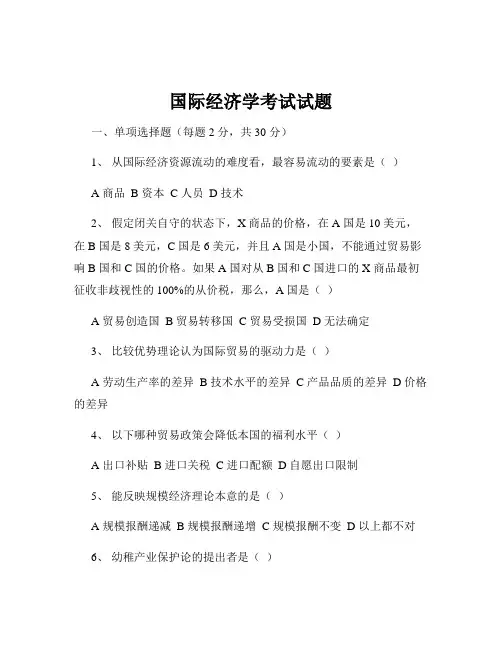
国际经济学考试试题一、单项选择题(每题 2 分,共 30 分)1、从国际经济资源流动的难度看,最容易流动的要素是()A 商品B 资本C 人员D 技术2、假定闭关自守的状态下,X 商品的价格,在 A 国是 10 美元,在 B 国是 8 美元,C 国是 6 美元,并且 A 国是小国,不能通过贸易影响 B 国和 C 国的价格。
如果 A 国对从 B 国和 C 国进口的 X 商品最初征收非歧视性的 100%的从价税,那么,A 国是()A 贸易创造国B 贸易转移国C 贸易受损国D 无法确定3、比较优势理论认为国际贸易的驱动力是()A 劳动生产率的差异B 技术水平的差异C 产品品质的差异D 价格的差异4、以下哪种贸易政策会降低本国的福利水平()A 出口补贴B 进口关税C 进口配额D 自愿出口限制5、能反映规模经济理论本意的是()A 规模报酬递减B 规模报酬递增C 规模报酬不变D 以上都不对6、幼稚产业保护论的提出者是()A 亚当·斯密B 大卫·李嘉图C 汉密尔顿D 李斯特7、当一国政府对某种产品征收进口关税时,若该产品的需求弹性大于供给弹性,生产者与消费者承担关税的程度是()A 前者大于后者B 后者大于前者C 两者相等D 不确定8、一国货币贬值对其进出口收支产生何种影响()A 出口增加,进口减少B 出口减少,进口增加C 出口增加,进口增加D 出口减少,进口减少9、在浮动汇率制下,当一国国际收支出现逆差时,该国货币汇率会()A 上升B 下降C 不变D 不确定10、以下哪项不是国际收支平衡表中的项目()A 经常项目B 资本项目C 错误与遗漏项目D 国内生产总值项目11、购买力平价理论的基础是()A 一价定律B 利率平价C 相对购买力平价D 绝对购买力平价12、国际收支调整的弹性分析法的假设前提不包括()A 不存在国际资本流动B 汇率由货币当局决定C 马歇尔勒纳条件成立D 进出口商品的供给弹性无穷大13、下列属于直接标价法的是()A 1 美元=68 人民币B 1 人民币=015 美元C 1 英镑=12 欧元D 1 欧元=085 英镑14、蒙代尔弗莱明模型主要分析在资本完全流动的情况下,()政策的有效性。
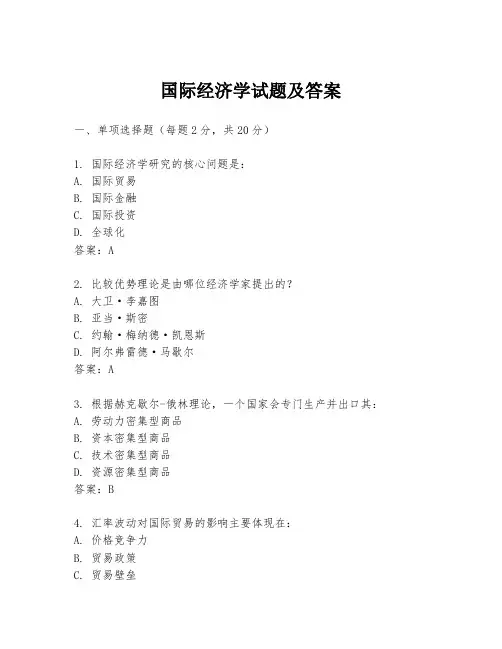
国际经济学试题及答案一、单项选择题(每题2分,共20分)1. 国际经济学研究的核心问题是:A. 国际贸易B. 国际金融C. 国际投资D. 全球化答案:A2. 比较优势理论是由哪位经济学家提出的?A. 大卫·李嘉图B. 亚当·斯密C. 约翰·梅纳德·凯恩斯D. 阿尔弗雷德·马歇尔答案:A3. 根据赫克歇尔-俄林理论,一个国家会专门生产并出口其:A. 劳动力密集型商品B. 资本密集型商品C. 技术密集型商品D. 资源密集型商品答案:B4. 汇率波动对国际贸易的影响主要体现在:A. 价格竞争力B. 贸易政策C. 贸易壁垒D. 贸易协定答案:A5. 国际货币基金组织(IMF)的主要职能不包括:A. 监督成员国的经济政策B. 提供短期贷款以解决国际收支不平衡C. 促进国际贸易自由化D. 为成员国提供技术援助答案:C6. 世界贸易组织(WTO)的主要目标是:A. 促进全球经济增长B. 减少全球贫困C. 促进国际贸易自由化D. 维护世界和平答案:C7. 根据购买力平价理论,如果一国的货币贬值,那么该国的:A. 出口会增加B. 进口会增加C. 出口和进口都会增加D. 出口和进口都不会增加答案:A8. 国际直接投资(FDI)与国际间接投资的主要区别在于:A. 投资规模B. 投资期限C. 投资方式D. 投资回报答案:C9. 跨国公司在全球范围内进行生产和销售活动,其主要目的是:A. 降低成本B. 增加市场份额C. 规避贸易壁垒D. 所有上述选项答案:D10. 国际经济一体化的主要形式不包括:A. 自由贸易区B. 共同市场C. 关税同盟D. 双边贸易协定答案:D二、多项选择题(每题3分,共15分)1. 以下哪些因素会影响一个国家的贸易模式?A. 资源禀赋B. 技术水平C. 消费者偏好D. 贸易政策答案:ABCD2. 国际收支平衡表主要包括以下哪些部分?A. 经常账户B. 资本和金融账户C. 储备资产D. 政府预算答案:ABC3. 以下哪些是国际经济一体化的积极效应?A. 贸易创造B. 规模经济C. 投资自由化D. 货币贬值答案:ABC4. 国际货币体系的主要功能包括:A. 提供稳定的汇率B. 促进国际贸易和投资C. 维护国际金融稳定D. 促进全球经济增长答案:ABC5. 国际金融市场的主要参与者包括:A. 银行B. 跨国公司C. 政府D. 个人投资者答案:ABCD三、简答题(每题5分,共20分)1. 简述绝对优势理论和比较优势理论的主要区别。
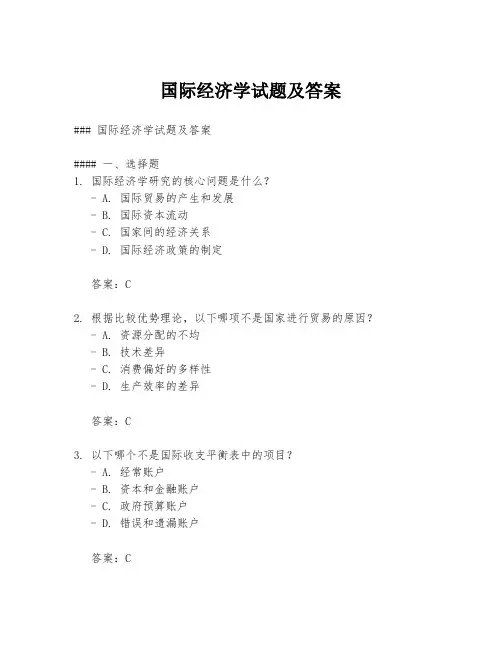
国际经济学试题及答案### 国际经济学试题及答案#### 一、选择题1. 国际经济学研究的核心问题是什么?- A. 国际贸易的产生和发展- B. 国际资本流动- C. 国家间的经济关系- D. 国际经济政策的制定答案:C2. 根据比较优势理论,以下哪项不是国家进行贸易的原因? - A. 资源分配的不均- B. 技术差异- C. 消费偏好的多样性- D. 生产效率的差异答案:C3. 以下哪个不是国际收支平衡表中的项目?- A. 经常账户- B. 资本和金融账户- C. 政府预算账户- D. 错误和遗漏账户答案:C#### 二、简答题1. 简述绝对优势理论的基本内容。
绝对优势理论由亚当·斯密提出,认为如果一个国家在生产某种商品上比其他国家更有效率,即生产成本更低,那么这个国家在该商品上具有绝对优势。
根据这一理论,具有绝对优势的国家应该专门生产并出口其具有绝对优势的商品,同时进口其他国家具有绝对优势的商品,从而实现资源的最优配置和国际贸易的互利。
2. 什么是保护主义?保护主义对国际贸易有何影响?保护主义是一种经济政策,旨在通过关税、配额、补贴等手段保护国内产业免受外国竞争的影响。
保护主义可能会提高国内产业的竞争力,但同时也可能导致资源配置效率降低,增加消费者成本,限制国际贸易的发展,并可能引发贸易战,对全球经济产生负面影响。
#### 三、计算题1. 假设一个国家生产小麦和玉米,生产一单位小麦需要4小时劳动,生产一单位玉米需要2小时劳动。
另一个国家生产一单位小麦需要6小时劳动,生产一单位玉米需要3小时劳动。
请计算两国的比较优势,并说明它们应该如何进行贸易。
- 第一个国家生产小麦的机会成本是0.5单位玉米(4小时/2小时),生产玉米的机会成本是2单位小麦(2小时/4小时)。
- 第二个国家生产小麦的机会成本是2单位玉米(6小时/3小时),生产玉米的机会成本是0.5单位小麦(3小时/6小时)。
第一个国家在生产小麦上有比较优势,因为它的机会成本较低(0.5 vs 2)。
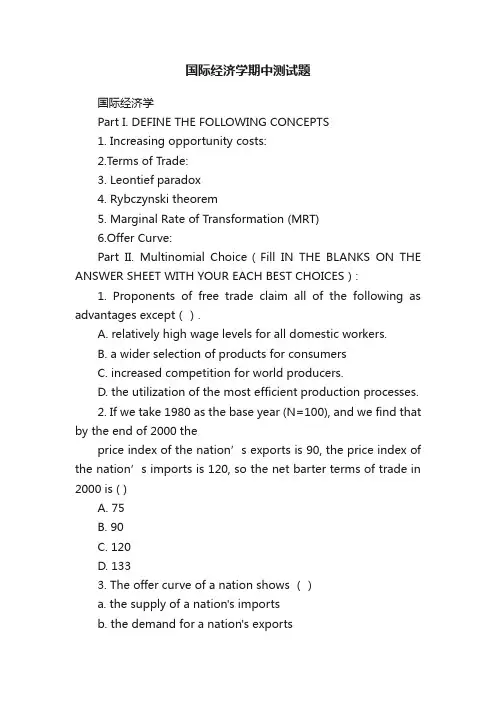
国际经济学期中测试题国际经济学Part I. DEFINE THE FOLLOWING CONCEPTS1. Increasing opportunity costs:2.Terms of Trade:3. Leontief paradox4. Rybczynski theorem5. Marginal Rate of Transformation (MRT)6.Offer Curve:Part II. Multinomial Choice(Fill IN THE BLANKS ON THE ANSWER SHEET WITH YOUR EACH BEST CHOICES):1. Proponents of free trade claim all of the following as advantages except().A. relatively high wage levels for all domestic workers.B. a wider selection of products for consumersC. increased competition for world producers.D. the utilization of the most efficient production processes.2. If we take 1980 as the base year (N=100), and we find that by the end of 2000 theprice index of th e nation’s exports is 90, the price index of the nation’s imports is 120, so the net barter terms of trade in 2000 is ( )A. 75B. 90C. 120D. 1333. The offer curve of a nation shows ()a. the supply of a nation's importsb. the demand for a nation's exportsc. the trade partner's demand for imports and supply of exportsd. the nation's demand for imports and supply of exports4. Export prices must rise for a nation to increase its exports because the nation ():A. incurs increasing opportunity costs in export productionB. faces decreasing opportunity costs in producing import substitutesC. faces decreasing marginal rate of substitution in consumptionD. all of the above5. Which of the following statements regarding partial equilibrium analysis is false?( )A. It relies on traditional demand and supply curvesB. it isolates for study one marketC. it can be used to determine the equilibrium relative commodity price but not theequilibrium quantity with tradeD. none of the above6.The Heckscher-Ohlin theory is based on a number of simplifying assumptions,which include(). (more than one answer for this question.)A. two nations, two commodities, and two factors of production;B. both nations use the same technology;C. incomplete specialization in production;D.no transportation costs, tariffs, or other obstructions to the free flow ofinternational trade.7.Technical progress that increases the productivity of Lproportionately more thanthe productivity of K is called ( ):A. capital savingB. labor savingC. neutralD. any of the above8. With increasing costs, specialization in production is( )A. completeB. incompleteC. complete in small country, incomplete in large countryD. complete in large country, incomplete in small country9.The Leontief paradox could be explained by ( ). (more than one answer for thisquestion.)A. the fact that U.S. tariffs gave more protection to L-intensive industriesB. the exclusion of human capital from the calculationsC. the use of a two-factor modelD. factor-intensity reversal10. If a production possibilities frontier is bowed out (concave to the origin), thenproduction occurs under conditions of ()A. constant opportunity costs.B. increasing opportunity costs.C. decreasing opportunity costs.D. infinite opportunity costs.Part ⅢTRUE(T)/FALSE(F)(MARK “T”OR “F” IN THE BLANKS WITH YOUR BEST JUDGEMENT ON THE ANSWER SHEET)。
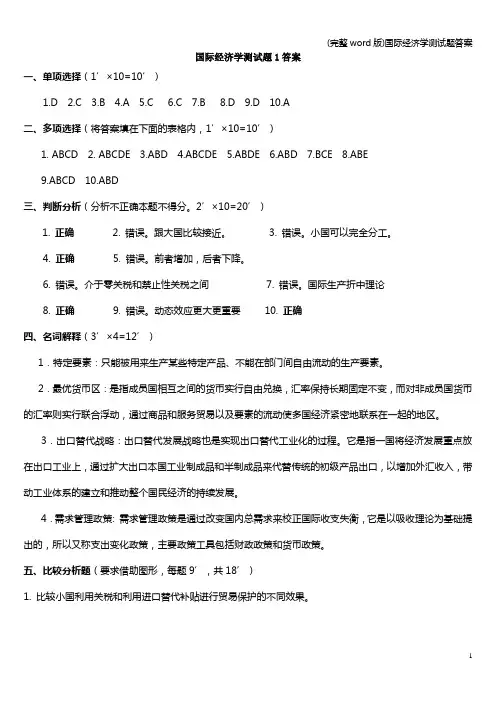
国际经济学测试题1答案一、单项选择(1’×10=10’)1.D2.C3.B4.A5.C6.C7.B8.D9.D 10.A二、多项选择(将答案填在下面的表格内,1’×10=10’)1. ABCD2. ABCDE3.ABD4.ABCDE5.ABDE6.ABD7.BCE8.ABE9.ABCD 10.ABD三、判断分析(分析不正确本题不得分。
2’×10=20’)1. 正确2. 错误。
跟大国比较接近。
3. 错误。
小国可以完全分工。
4. 正确5. 错误。
前者增加,后者下降。
6. 错误。
介于零关税和禁止性关税之间7. 错误。
国际生产折中理论8. 正确9. 错误。
动态效应更大更重要10. 正确四、名词解释(3’×4=12’)1.特定要素:只能被用来生产某些特定产品、不能在部门间自由流动的生产要素。
2.最优货币区:是指成员国相互之间的货币实行自由兑换,汇率保持长期固定不变,而对非成员国货币的汇率则实行联合浮动,通过商品和服务贸易以及要素的流动使多国经济紧密地联系在一起的地区。
3.出口替代战略:出口替代发展战略也是实现出口替代工业化的过程。
它是指一国将经济发展重点放在出口工业上,通过扩大出口本国工业制成品和半制成品来代替传统的初级产品出口,以增加外汇收入,带动工业体系的建立和推动整个国民经济的持续发展。
4.需求管理政策: 需求管理政策是通过改变国内总需求来校正国际收支失衡,它是以吸收理论为基础提出的,所以又称支出变化政策,主要政策工具包括财政政策和货币政策。
五、比较分析题(要求借助图形,每题9’,共18’)1. 比较小国利用关税和利用进口替代补贴进行贸易保护的不同效果。
征收关税之后,该国的总福利水平下降了:消费者剩余损失了(a+b+c+d),其中a被生产者所得,c为政府财政收入所得,但尚有b和d的损失,国内没有任何人能得到相应的补偿。
这是由于关税使本国的生产资源从效率较高的部门转移到了效率较低的部门,即一国的生产资源向没有比较优势的进口竞争部门集中,因此造成了国民福利净损失。
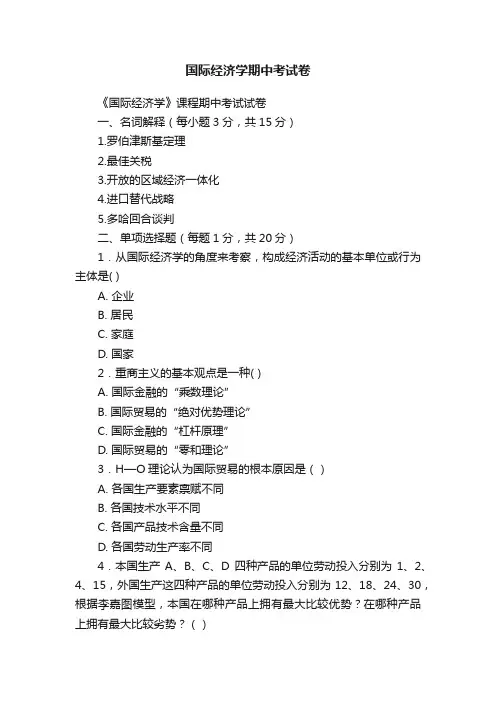
国际经济学期中考试卷《国际经济学》课程期中考试试卷一、名词解释(每小题3分,共15分)1.罗伯津斯基定理2.最佳关税3.开放的区域经济一体化4.进口替代战略5.多哈回合谈判二、单项选择题(每题1分,共20分)1.从国际经济学的角度来考察,构成经济活动的基本单位或行为主体是( )A. 企业B. 居民C. 家庭D. 国家2.重商主义的基本观点是一种( )A. 国际金融的“乘数理论”B. 国际贸易的“绝对优势理论”C. 国际金融的“杠杆原理”D. 国际贸易的“零和理论”3.H—O理论认为国际贸易的根本原因是()A. 各国生产要素禀赋不同B. 各国技术水平不同C. 各国产品技术含量不同D. 各国劳动生产率不同4.本国生产A、B、C、D 四种产品的单位劳动投入分别为1、2、4、15,外国生产这四种产品的单位劳动投入分别为12、18、24、30,根据李嘉图模型,本国在哪种产品上拥有最大比较优势?在哪种产品上拥有最大比较劣势?()A.D、A B.C、BC.A、D D.B、C5.假定每单位A 产品的生产需要20 单位劳动与4 单位土地,每单位B 产品的生产需要1 单位劳动与4 单位土地,如果本国有1200 单位劳动与2000 单位土地,外国有400 单位劳动与500 单位土地,根据H-O 理论可推出()A.本国出口A 产品、进口B 产品B.本国出口B 产品、进口A 产品C.本国出口A 产品、B 产品D.本国进口A 产品、B 产品6.重叠需求理论的提出者是()A.林德 B.波斯纳C.弗农 D.克拉维斯7.产品生命周期理论试图从什么角度解释国际贸易形态的动态特征?()A.技术差距 B.技术变化C.需求结构 D.收入水平8.不能用来解释产业内贸易现象的理论是()A.重叠需求理论 B.要素禀赋理论C.规模经济理论 D.垄断竞争理论9.以下属于古诺模型的基本假设的是()A. 假设市场中只有一个厂商B. 假设市场中只有两个厂商C. 假设厂商行为模式是合作型的D. 假设厂商行为模式是勾结型的10.以下关于有效保护率的说法不正确的是()A.如果最终产品的名义关税大于中间投入品的名义关税,则最终产品的有效保护率大于其名义税率B.如果最终产品的名义关税等于中间投入品的名义关税,则最终产品的有效保护率等于其名义税率C.在最终产品进口税率不变的情况下,中间投入品关税不断提高,有效保护率不断下降D.要提高对某项行业的保护程度,可以通过提高中间投入品进口税率的方法来实现11.征收进口关税对生产者来说()A.生产者剩余减少 B.生产者剩余不变C.生产者剩余增加 D.生产者的产品价格将下降12.为了排除市场上的竞争对手,出口商暂时以较低的价格向国外市场销售商品,一旦达到目的、获取垄断地位以后,企业又会重新提高价格,以获取垄断性的超额利。
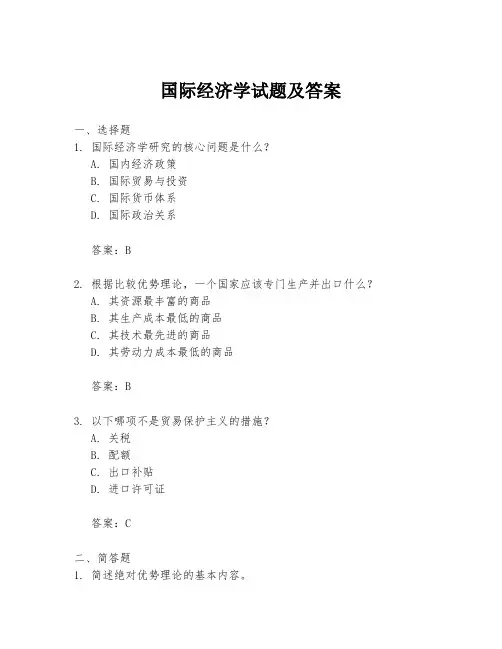
国际经济学试题及答案一、选择题1. 国际经济学研究的核心问题是什么?A. 国内经济政策B. 国际贸易与投资C. 国际货币体系D. 国际政治关系答案:B2. 根据比较优势理论,一个国家应该专门生产并出口什么?A. 其资源最丰富的商品B. 其生产成本最低的商品C. 其技术最先进的商品D. 其劳动力成本最低的商品答案:B3. 以下哪项不是贸易保护主义的措施?A. 关税B. 配额C. 出口补贴D. 进口许可证答案:C二、简答题1. 简述绝对优势理论的基本内容。
答案:绝对优势理论由亚当·斯密提出,主张一个国家应该生产并出口其生产效率最高的商品,进口其生产效率最低的商品。
该理论认为,即使一个国家在所有商品的生产上都没有绝对优势,它仍然可以通过专业化生产效率相对较高的商品来获得贸易利益。
2. 什么是国际收支平衡表?答案:国际收支平衡表是一个记录一个国家与其他国家之间所有经济交易的统计报表。
它包括经常账户、资本和金融账户以及官方储备账户。
经常账户记录商品和服务的交易,资本和金融账户记录资本流动和金融资产的交易,官方储备账户记录中央银行的外汇储备变动。
三、论述题1. 论述汇率变动对国际贸易的影响。
答案:汇率变动对国际贸易有重要影响。
当一个国家的货币升值时,其出口商品在国际市场上的价格上升,竞争力下降,导致出口减少;同时,进口商品的价格下降,国内消费者更倾向于购买外国商品,导致进口增加。
相反,当一个国家的货币贬值时,其出口商品的价格下降,竞争力增强,促进出口;进口商品的价格上升,抑制进口。
此外,汇率变动还会影响跨国公司的投资决策,因为投资成本和收益会随着汇率变动而变化。
2. 分析全球化对发展中国家的影响。
答案:全球化为发展中国家带来了机遇和挑战。
机遇方面,全球化促进了资本、技术和信息的流动,为发展中国家提供了更多的市场机会和投资机会,有助于提高生产效率和经济增长。
挑战方面,全球化加剧了国际竞争,对发展中国家的产业和就业产生压力,可能导致收入差距扩大。
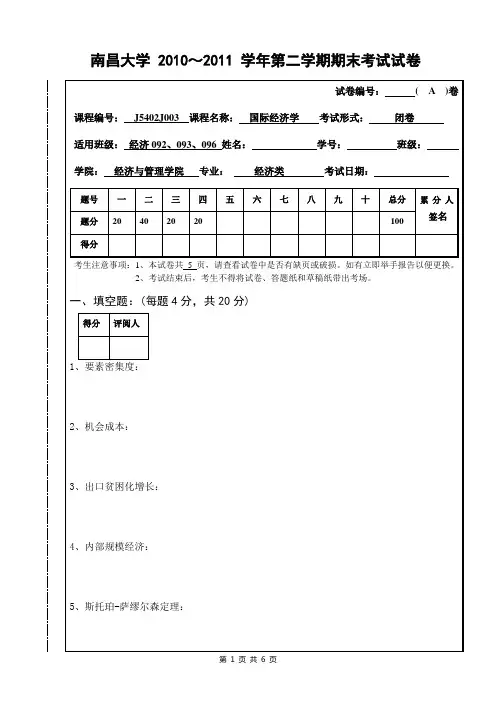
南昌大学 2010~2011 学年第二学期期末考试试卷试卷编号:( A )卷课程编号:J5402J003 课程名称:国际经济学考试形式:闭卷适用班级:经济092、093、096 姓名:学号:班级:学院:经济与管理学院专业:经济类考试日期:题号一二三四五六七八九十总分累分人签名题分20 40 20 20 100得分考生注意事项:1、本试卷共5 页,请查看试卷中是否有缺页或破损。
如有立即举手报告以便更换。
2、考试结束后,考生不得将试卷、答题纸和草稿纸带出考场。
一、填空题:(每题4分,共20分)得分评阅人1、要素密集度:2、机会成本:3、出口贫困化增长:4、内部规模经济:5、斯托珀-萨缪尔森定理:二、简答题(每题8分,共40分)得分评阅人1、简述斯密对重商主义的批判。
2、简述同质产品产业内贸易产生的主要原因。
3、运用局部均衡分析方法分析大国出口补贴的经济效应及净福利变化。
4、试用有关贸易理论说明为什么赞成自由贸易的一般是出口部门投资者,主张贸易限制的一般是进口部门投资者。
5、运用局部均衡分析方法分析关税同盟的贸易创造效应和贸易转移效应。
三、计算分析题(每题10分,共20分)得分评阅人1、假设中国生产价值10万美元汽车需要7万美元的零部件;中国进口整车的名义税率为30%,。
试计算进口汽车零部件的名义税率分别为50%、30%、10%时,关税对中国汽车行业的有效保护率,并说明发展中国家为了兼顾有效保护率和本国原材料行业发展,应如何合理确定关税结构。
2、根据表中数据判断:①哪个国家资本相对丰富?②哪个国家劳动相对丰富?③假设不存在要素密集度颠倒,X产品的劳动投入系数为5,资本投入系数为15,Y产品的劳动投入系数为4,资本投入系数为8。
根据要素禀赋理论判断,两国的比较优势如何?两国的生产和贸易模式应如何确定?要素禀赋A国B国资本20 36劳动10 12四、论述题(20分)得分评阅人结合图形阐述国际贸易产品生命周期理论的主要内容,并说明该理论可以解释什么贸易现象。
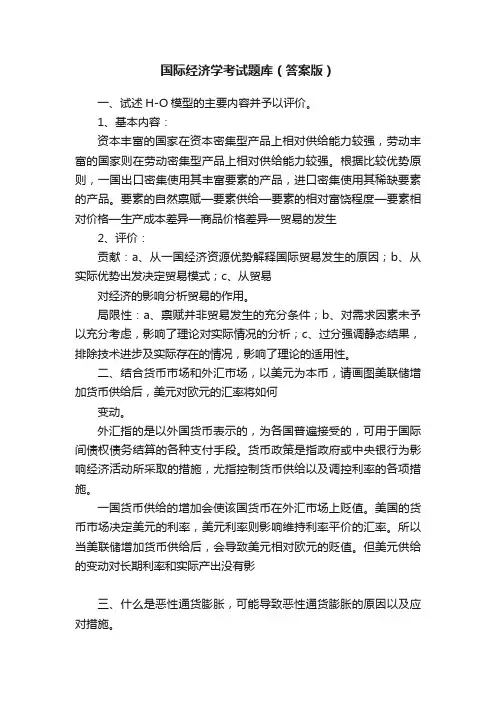
国际经济学考试题库(答案版)一、试述H-O模型的主要内容并予以评价。
1、基本内容:资本丰富的国家在资本密集型产品上相对供给能力较强,劳动丰富的国家则在劳动密集型产品上相对供给能力较强。
根据比较优势原则,一国出口密集使用其丰富要素的产品,进口密集使用其稀缺要素的产品。
要素的自然禀赋—要素供给—要素的相对富饶程度—要素相对价格—生产成本差异—商品价格差异—贸易的发生2、评价:贡献:a、从一国经济资源优势解释国际贸易发生的原因;b、从实际优势出发决定贸易模式;c、从贸易对经济的影响分析贸易的作用。
局限性:a、禀赋并非贸易发生的充分条件;b、对需求因素未予以充分考虑,影响了理论对实际情况的分析;c、过分强调静态结果,排除技术进步及实际存在的情况,影响了理论的适用性。
二、结合货币市场和外汇市场,以美元为本币,请画图美联储增加货币供给后,美元对欧元的汇率将如何变动。
外汇指的是以外国货币表示的,为各国普遍接受的,可用于国际间债权债务结算的各种支付手段。
货币政策是指政府或中央银行为影响经济活动所采取的措施,尤指控制货币供给以及调控利率的各项措施。
一国货币供给的增加会使该国货币在外汇市场上贬值。
美国的货币市场决定美元的利率,美元利率则影响维持利率平价的汇率。
所以当美联储增加货币供给后,会导致美元相对欧元的贬值。
但美元供给的变动对长期利率和实际产出没有影三、什么是恶性通货膨胀,可能导致恶性通货膨胀的原因以及应对措施。
恶性通货膨胀又称“超速通货膨胀”,是三位数以上的通货膨胀。
指流通货币量的增长速度大大超过货币流通速度的增长,货币购买力急剧下降,物价水平加速上升,整体物价水平以极高速度快速上涨的现象,使民众对货币价值失去信心。
由于货币的流通量增加快速,使货币变得没有价值时,人们会急于要以货币换取实物,人心惶惶的结果只会更加速通货膨胀的恶化,整体经济濒临崩溃边缘。
恶性通货膨胀是一种不能控制的通货膨胀,在物价很快地上涨的情况下,就使货币失去价值。
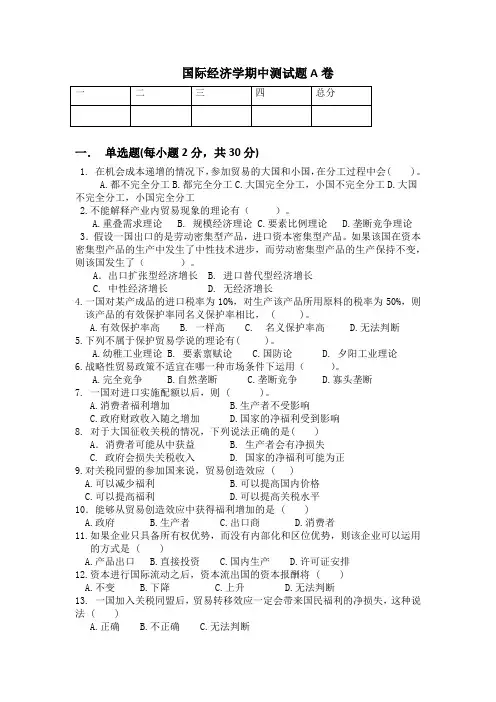
国际经济学期中测试题A卷一.单选题(每小题2分,共30分)1. 在机会成本递增的情况下,参加贸易的大国和小国,在分工过程中会( )。
A.都不完全分工B.都完全分工C.大国完全分工,小国不完全分工D.大国不完全分工,小国完全分工2.不能解释产业内贸易现象的理论有()。
A.重叠需求理论B. 规模经济理论C.要素比例理论D.垄断竞争理论3.假设一国出口的是劳动密集型产品,进口资本密集型产品。
如果该国在资本密集型产品的生产中发生了中性技术进步,而劳动密集型产品的生产保持不变,则该国发生了()。
A.出口扩张型经济增长 B. 进口替代型经济增长C. 中性经济增长D. 无经济增长4.一国对某产成品的进口税率为10%,对生产该产品所用原料的税率为50%,则该产品的有效保护率同名义保护率相比, ( )。
A.有效保护率高B. 一样高C. 名义保护率高D.无法判断5.下列不属于保护贸易学说的理论有( )。
A.幼稚工业理论B. 要素禀赋论C.国防论D. 夕阳工业理论6.战略性贸易政策不适宜在哪一种市场条件下运用()。
A.完全竞争B.自然垄断C.垄断竞争D.寡头垄断7. 一国对进口实施配额以后,则 ( )。
A.消费者福利增加B.生产者不受影响C.政府财政收入随之增加D.国家的净福利受到影响8. 对于大国征收关税的情况,下列说法正确的是( )A.消费者可能从中获益 B. 生产者会有净损失C. 政府会损失关税收入D. 国家的净福利可能为正9.对关税同盟的参加国来说,贸易创造效应 ( )A.可以减少福利B.可以提高国内价格C.可以提高福利D.可以提高关税水平10.能够从贸易创造效应中获得福利增加的是 ( )A.政府B.生产者C.出口商D.消费者11.如果企业只具备所有权优势,而没有内部化和区位优势,则该企业可以运用的方式是 ( )A.产品出口B.直接投资C.国内生产D.许可证安排12.资本进行国际流动之后,资本流出国的资本报酬将 ( )A.不变B.下降C.上升D.无法判断13. 一国加入关税同盟后,贸易转移效应一定会带来国民福利的净损失,这种说法 ( )A.正确B.不正确C.无法判断14.跨国公司利用商品市场或要素市场的某种垄断优势地位来追求利润最大化,是外国直接投资的根本动因。
国际经济学测试题1一、单项选择(1’×10=10’)1.重商主义者认为国际贸易()。
A.是一种双赢行为 B. 对其中的强国有利C.对其中的弱国有利 D. 是一种零和行为2.斯密的绝对优势理论假定增加某种产品的生产所放弃的另一种产品生产的代价是()。
A.递增的 B. 递减的C. 不变的D. 不确定的3.如果说一国的资本要素比较丰裕,就意味着()。
A. 该国的资本要素总量较多B. 该国的W/R的值较大C. 该国的K/L的值较小D. 该国的生产中较多使用技术4.根据特定要素模型,国际贸易的受损者为()。
A. 进口竞争部门的特定要素所有者B. 进口竞争部门的流动要素所有者C. 出口部门的特定要素所有者D. 出口部门的流动要素所有者5.根据产品生命周期理论,发明国的新产品出口()。
A. 在产品问世的时候即已开始B. 贯穿整个生命周期C. 是一个先增加然后逐渐减少的过程D. 以上三者都正确6. 在局部均衡分析中,与小国相比,大国征收关税的主要不同在于()。
A. 保护效应更明显B. 消费效应更明显C. 能够改善贸易条件D. 对政府税收没有影响7.如果一国在征收进口税时,对最终产品征收的关税低于中间产品,则可以使关税的实际保护效果()。
A. 增大B. 变小C. 没有影响D. 无法判断8.购买力平价理论的基础是()。
A. 粘性价格的存在B. 货币数量理论C. 马歇尔-勒纳条件D. 一价定律9.根据吸收分析法,贬值一定会()。
A. 导致国内总收入的增加B. 改善国际收支C. 促使国内货币供求重新平衡D. 上述说法都不对10. 根据斯旺图示,用来调节外部均衡的手段是()。
A. 支出转换政策B. 支出调整政策C. 本国的货币政策D. 本国的财政政策二、多项选择(1’×10=10’)1. 能够解释二战以后国际贸易流向新格局的理论包括()。
A.规模经济理论 B. 产业内贸易理论C.产品差异化理论 D. 需求偏好相似理论E.要素禀赋理论2. 对里昂惕夫之谜进行解释的学说包括()。
国际经济学试题及答案(题库)国际经济学习题集及参考答案一、填空、选择、判断题(每题1分):第一章:1、国际贸易理论以微观经济学原理为基础,讨论世界范围内的资源配置问题。
2、最常用国际贸易模型的结构形式为两个国家、两种产品(或部门)和两种要素。
3、在完竞争的假设前提下,封闭条件下的相对价格是国际贸易产生的基础。
4、国家间的供给、需求方面的差异是造成相对价格的根源。
5、贸易后,国际均衡价格由两国的供需共同决定,国际均衡价格处于两国封闭下的相对价格之间。
6、国际贸易利益包括两个部分:来自交换的利益和来自专业化的利益。
7、贸易理论主要围绕三个问题展开:国际贸易的格局、国际贸易的条件、国际贸易的收益。
第二章:1、斯密的绝对优势论认为国际贸易的基础是各国之间劳动生产率的绝对差别;李嘉图的比较优势论认为国际贸易的基础是各国之间劳动生产率的相对差别。
2、哈伯勒首先用机会成本概念来阐明比较优势论。
3、重商主义者提倡的国家经济政策有:限制进口和鼓励出口,采取奖金、退税、协定和殖民地贸易等措施鼓励出口。
4、李嘉图认为在国际贸易中起决定作用的不是绝对成本,而是相对成本。
5、斯密的绝对优势论认为国际贸易的基础是各国之间劳动生产率的绝对差别;劳动生产率的比较优势论认为国际贸易的基础是各国之间劳动生产率的相对差别。
6、在李嘉图模型中,生产可能性边界线方程是一个线性方程式,表示A、B两国的PPF曲线是一条直线段。
7、重商主义者提倡的国家经济政策有:限制进口和鼓励出口,采取奖金、退税、协定和殖民地贸易等措施鼓励出口。
8、李嘉图认为在国际贸易中起决定作用的不是绝对成本,而是相对成本。
9、机会成本概念表明:彼种选择的机会成本就构成此种选择的机会成本。
选择题:1、首先用机会成本理论来解释比较优势原理的学者是: C、A、李嘉图B、罗布津斯基C、哈伯勒D、穆勒第三章:1、要素禀赋理论最初是由赫克歇尔和俄林提出的,后经萨缪尔森等人加工不断完善。
淮海工学院2010- 2011学年第一学期国际经济学试卷(A开卷)一、名词解释(本大题共5小题,每小题3分,共15分)1.外部规模经济2.赫克歇尔-俄林定理3.重叠需求4.外汇储备5.对外贸易乘数二、单项选择题(本大题共10小题,每小题2分,共20分)1.国际贸易利益包括了( A )两部分。
A.交换的利益和专业化的利益B.劳动生产率的利益和比较优势的利益C.要素禀赋的利益和交换的利益D.技术的利益和偏好的利益2.下列贸易理论与规模经济无关的有( D )A.产品差异理论B.重叠需求理论C.相互倾销理论D.嗜好理论3.假设某一行业(X1)需要另两个行业(X2 和X3)的产品作为中间投入,投入产出系数分别为α21=0.2,α31=0.5,三个行业的进口关税分别用T1、T2和T3表示,当T1=30%、T2=20%、T3=40%时,X1 的有效保护率是(B )A.70% B.20% C.30% D.60%4.下列(D)行业最有可能具有内部规模经济。
A.好莱坞的电影城;B.加州的硅谷C.北京中关村的电脑城D.美国的大型农场5.在垄断竞争模型中(B)A.如果两国拥有相同的总体资本—劳动比例,它们之间就不会发生贸易。
B.贸易导致了商品品种的增多和规模经济效应的扩大,进而可以带来收益。
C.从产气来看,厂商可以获益D.要素禀赋并不能决定产业间贸易的发生6.初级产品价格发生显著摸顶的原因是(D )A.随着收入增加,需求显著增加B.供给对价格的弹性很大C.需求对价格的弹性很大D.需求和供给对价格缺乏弹性7.跨国公司进行国际合资可能出于以下原因,除了( C )A.获得更先进技术和管理技巧B.服从东道国政府的限制规定C.更有效地融合不同国家的语言和文化D.实现全球生产工厂之间的密切协调8.必须在90天内支付100万瑞士法郎的美国进口商可以通过(A )方式转嫁美圆贬值的风险。
A.在远期市场上买进90天期的法郎B.在远期市场上卖出90天期的法郎C.在远期市场上买进法郎,90天后在即期市场上卖出D.在远期市场上卖出法郎,90天后在即期市场上买进9.下面各项中,应记入美国国际收支帐户借方的是( C )A.一家墨西哥企业向美国银行归还贷款B.美国投资者收到日本基金支付的债券股息C.伦敦罗意德保险公司向克莱斯勒公司出售一份保险单D.日本丰田公司在肯塔基州建立一家汽车装配工厂110.关于在固定汇率下的宏观经济政策的有效性(资本完全流动),说法不正确的是(C )A.任何国家都不可能独立地执行货币政策B.执行的财政政策是有效的C.扩张性的财政政策的长期效果是使利率上升,收入提高D.扩张性的财政政策的长期效果是使利率恢复到原来的水平,国际收支平衡为止三、判断题(本大题共10小题,每小题2分,共20分)1.两国贸易时,贸易条件均衡等于较小国家贸易前的现行国内价格比。
Mid-term Examination for International EconomicsLMultiple choices: 30%1.Mercantilists believedA.That trade can only benefit a country at the expense of all other countries・B.That maintaining a balance of trade surplus was best.ernment should have no control over trade.D.Amassing large quantities of gold and silver were damaging to the health of a country.2.Specialization in production is ______ with _______ ・A.Incomplete; constant costsB.Incomplete; increasing costsC.Variable; constant costsplete; increasing costs3.China is relatively labor-abundant and Australia is relatively land-abundant. Textiles are relatively more labor-intensive than the production of wool According to Hcckschcr-Ohlin (H-O) theory, Australia will have:A.A comparative advantage in textiles. B・ An absolute advantage in textiles.C.A comparative advantage in wool.D. An absolute advantage in wool.4.Considering a world economy with two goods, two countries・ Suppose country 1 specializes in and exports commodity x in exchange of commodity y. Which of the following is the possible basis for international trade according the absolute advantage theory ?A.The unit labor requirment in x production is less in Country 2 than that in Country 1 ・B.The relative price of x in Country 1 exceeds the relative price of x in country 1C・ Country 1 can produce a unit of x with less labor than country 2D.All of the above.5.Which of the following is not the assumption generally used in the study of classical intcrnational trade theory?A.perfect competitionB.difference in factor endowmentplete specializationD.pefect intemaional moility of factors6.Gains from trade can be demonstrated in the neoclassical model by noting thatA.trade leads to specializationB.trade brings out diversity in consumptionC.trade results in more consumption above the production possbility frontierD.trade allows a country to learn new technology7.Which of the following is not long-run results of free trade:modity prices equalize between countries.B.Countries specialize more・C.One country gains while the other loses・D.Factor prices equalize between countries・8.In a labor-abundant country:A.Wage rates will fall with the opening of free trade・B.Wage rates will rise with the opening of fi-ee trade.C・ Wage rates will stay the same with the opening of free trade.D・ The change of wage rates is ambiguous・9. Which of the following would be winners when trade breaks out in a land abundant country:ndownersB. workersC. capital owners D・ all of them10.If the U.S. has a comparative advantage in the production of corn (land-intensive, and has a comparative disadvantage in the production of textiles (labor-intensive., in the short-mn, landowners in which sectors would gain?A. cornB. textilesC. bothD. neither11 ・Before trade, Australia is relatively abundant in capital and China is relatively abundant in labor. We would expect that the incomes of ________ in China and of _________ in Australia would increase・12.Heckscher-Ohlin theory can also be called:A.The theory of comparative advantage・B・ Factor-endowment theory.C・ The theory of absolute advantage・ D. The factor-proportions theory.13.Gains from trade can be broken down into two components:A.From exchange;from spccializationB.From specialization; from progress in producitivityC.From the technology change;from specializationD・ From factor transition; from exchange14.Which of the following is one of the assumptions of the H-O Model?A.Nations use diffcrcncc tech no logy in productionB.Both commodities are produced under increasing returns to scaleC.Tastes are equal in both nationsD・ There is imperfect factor mobility within each nation and no international factor mobility15.Equilibrium Relative Commodity Price with trade detennined byA.Mutual demand and supply in the world marketB.Trade neogiation between the two countriesC.The international unit labor requirments of the commodityD.The management by both governments16.Which of the following can lead to international tradeA.diffcrcnccs in taste B・ differences in resourcesC・ differences in productivity D. all of the above17.The Leontief Paradox found fault with:A.The theory of absolute advantage・B. The theory of comparative advantage・C.Heckschcr・Ohlin (H-O) theory.D. The Factor Price Equalization theorem.18.IfY production uses 80 workers and 200 units of capital, while X production uses 20 workers and 20 units of capital, thenA.Y production is Capital intensiveB.X production is Capital intensiveC.If country 1 is labor aboundant, she should specialize in and export X.D.All of the above are false.19.In a specific factors model, the increase of price of manufocturcs will not leads tobor shifts from the food sector to the manufacturing sectorB.output of manufactures rises while that of food falls.C.Workers are definitely better offD.The wage rate rises in both sectors.20.Only doubling labor with trade in a large labor-abundant country _____ ・A. deteriorate the country's terms of trade B・ can increase or reduces the volume of tradeC.reduces the country's social welfareD.all of the above・2 l.The Rybczynski theorem postulates that doubling labor at constant relative commodity price _____ ・A.doubles the output of the labor-intensive commodityB.reduces the output of the capital-intensive commodityC.keeps the output of the capital-intensive commodity unchanged23. A monopoly firm engaged in international trade will _____ . A. equate average to local costsB. equate marginal costs with foreign marginal revenuesC. equate marginal costs with the highest price the market will bearD. equate marginal costs with marginal revenues in both domestic and foreign markets.24.If some industries exhibit internal increasing returns to scale in each country, wc should NOT expect to see ______ ・A. intra-industiy trade between countriesB.perfect competition in these industriesC.interindustry trade between countriesD.high levels of specialization in both countries25.In the domestic monopolistically competitive market, as the number of varieties increases, the price ________ and the unit cost26.A product is produced in a monopolistically competitive industry with scale economies ・ If this industry exists in two countries, and these two countries engage in trade one with the other, we would expectA. the country in which the price of the product is lower will export the product.B. thc country with a relative abundance of the factor of production in which production ofC. the product is intensive will export this product.D. each of the countries will export different varieties of the product to the other.27.International trade based on internal scale economies in both countries is likely to be carried out by a ______ ・A. relatively large number of price competing firmsB. relative small number of price competing firmsC. relative small number of competing oligopolistsD. monopoly firms in each country/industry.28. Which of the following is not correct about the intraindustry trade and intraindustry trade:A The basis for trade in interindustiy trade is comparative advantage, and that in intraindustry trade is not comparative advantageB The pattern of inteeindustry trade itself is unpredictable, and the pattern of interindustry can be predicted through the pretrade relative price of commodites.C If Home and Foreign are similar, there will be more interindustry trade ・D Intraindustry trade can make all factors better off.29. Which of the following factors would NOT be likely to contribute to a worsening of the terms of trade of developing countries?A. Heavy reliance on primary production exports ・B. The differing price effects of technological change compared to developed countries ・C. Developing countries' attempts to diversify their exports and include more manufactured goods in their export commoditiesD. Differences in the demand characteristics of the developing countries' exports and imports.30. Assume a country that produces cloth and coal. Assume that cloth production requires significant amounts of labor and capital, but relatively little land. Assume that coal production requires relatively little labor and capital, but relatively large amounts of coal-rich land. Given increases in the country's endowments of capital and labor, we can expect thatA. both cloth and coal production will in crease ・A.increases; increasesB. increases; decreasesC. decreases; increasesD.decreases; decreases D.any of the above.B.cloth production will increase, but coal production will remain constant.C.coal production will increase, but cloth production will remain constant.D.cloth production will increase, but coal production will decline・II.True or False:10%31.To increase one country's wealth, the country must sell more to strangers than consume of theirs in value yearly.32.If one nation is less efficient than the other country in the production of both commodities, there is not a basis for mutuallybeneficial trade・33.The Ricardian model explains why abosulute advantage is not nessecarily for international trade.34.Countrics A and B have two factors of production, capital and labor, with which they produce two goods, X and Y.Technology is the same in the two countries・ Good X is capital intensive; Country A is capital abundant. An increase in A's labor induces an increase in B、s terms of trade・35.Increasing opportunity cost arise when resources are perfect substitutes for each other or used in fixed proportion in theproduction.36.Small Country have no effects on the relative price on the world market37.The Heckscher-Ohlin model with two factors of production, labor and capital, shows that free trade between the US andMexico would lower US wages to the level of Mexican wages that prevails prior to the opening to trade・3& In a specific factors model, where labor is the mobile factor, trade is beneficial for the workers of the export secto匚39.Foreign competition is unfair and hurts other countries when it is based on low wages・40.Free trade is beneficial only for strong economics・III.Essay questions: 20%41.Consider an economy where the factors of production are labor (mobile) and capital (sector-specific in the Specific Factors model and mobile in the Heckscher-Ohlin model). Contrast the welfare effect of trade on the capital owners in the Specific Factors and the Hcckschcr-Ohlin models.42.What is the Leontief Paradox? Give two explanations to it.43.Many theoretical trade models assume that all goods are perfect substitutes and that all goods are traded・ There are also many models that specify the existence of non-lraded goods or that traded goods are imperfect substitutes. What are the implications for the H・O model with non-traded goods and/or goods that are imperfect substitutes?IV.Graphic problems or quantitative problems: 40%44.Specific model. Suppose that the United States produces only food and manufactures. Land is a specific factor input in food production and capital is a specific factor input in manufactures while labor is freely allocated across both sectors of the economy. All of a sudden, agricultural policy in the European Union induces an increase in the world food supply and reduces the international price of food. Illustrate the impact of the reduction in the price of food on the US labor demand curves for food and manufactures. What is the impact on labor allocation in the US and what is the impact on the wage rate? 45. Ricardian model. Suppose the unit labor requirements (the number of hours of labor required to produce one unit commodity) for country I and 2 are the following:Country 1 Country 2corn 2 20banana 6 48tomato 5 20apples 7 20wheat 12 645.1Suppose that all residents in both countries merely consume tomato and wheat. Then which goods will country Aproduce and export? Which goods will country B produce and export?45.2This problem is based on 29」・Suppose that every country has 120 hours of labors・ Prove that each country canbenefit from trade under such assumptions・45.3If the wage rate in A is five times that of B, which goods will country A export? which goods will country B export?46. A free-trade equilibrium exists in a two-region, two-product world. The United States trade with the Rest-of^the-World,exporting manufacturing and importing energy. Suppose that environmental consciousness has reduced the demand for energy in the US.46.1.At given international price, what is the effect in the US of this change in demand on the desired levels of imports andof exports?46.2.Illustrate this result on a graph showing the inipact of this decline in the demand for energy on the US offer curve ・46.3Assume that the United States is large enough to influence international prices, show on the previous graph how thisreduction in the demand for energy in the US affects the equilibrium international price ratio and volume of trade.46.4Show on a PPF graph and explain the eftect of this change in the terms of trade in the Rest of the World on Rest of theWorld's welfare・47. Monopolistic competition and international trade・Imagine an industry consisting of a number of firms producingdifferentiated products. The particular equation for the demand and the for the cost facing a firm are:Q = S X [1/n-b X (P — P*)]AC = F/Q + cwhere:Q is the firm's sales, S is the total sales of the industry, n is the number of firms in the industry, b is a constant term representing the responsiveness of a firm's sales to its price, P is the price charged by the firm itself, and P* is the average price charged by other competitors・Assume the following: b = 1/30000, F = $750,000,000, c = $5000 .And assume there are two countries (Home and Foreign) that have the same costs of automobile production. Annual sales of automobiles are 1600 million at Home and 4900 million at Foreign.47.1Show the equilibrium price and numbers of firms of Home and Foreign in the absence of trade.47.2Show the equilibrium price and numbers of firms of Home and Foreign in open economies・一.单项选择:BBCCDCCBABBDACADCACABBDBCDDCCD二.判断对错xxppx xpxxx三.简答1.7分要点:1)特定要素模型中的资本属于特定要素,在国际贸易后,资本柑对丰裕的国家出口特定被特定使用的产品,并从中获益;反Z,资本相对稀缺的国家资本受损。
国际经济学试卷(A)
一、选择题(2x15=30,每题只有一个正确答案)
1、如果dx、sx、dm和sm分别代表出口产品的需求弹性、出口产品的供给弹性、进口产品的需求弹性和进口产品的供给弹性,则马歇尔—勒纳条件用公式表示为()A.|dx+dm|>1 B.|dx+sx|>1
C.|dm+sm|>1 D.|sx+sm|>1
2. “贫困化增长”的一个必要条件为:()
A.国家的增长偏向于出口产业。
B.外国对该国的出口需求具有价格弹性。
C.国家的消费偏好高度偏向于出口商品。
D.贸易在国民经济中比重不大。
3、从国际贸易对生产要素收入分配的短期影响来看,自由贸易会导致()
A.生产进口竞争品部门使用的专门生产要素收入水平提高
B.生产进口竞争品部门使用的共同生产要素收入水平下降
C.生产出口品部门使用的共同生产要素收入水平提高
D.生产出口品部门使用的专门生产要素收入水平提高
4、在商品的国际比价保持不变的情况下,偏向出口的生产要素增长会()
A.扩大出口品生产规模 B.扩大进口品生产规模
C.使贸易规模保持不变 D.使贸易规模缩减
5、在货币主义的汇率决定理论中,与本币价值负相关的变量是()
A.本国国民收入 B.外国国民收入
C.外国的利息率 D.外国货币供给
6、不能解释产业内贸易现象的理论是()
A.重叠需求理论 B.规模经济理论
C.要素禀赋理论 D.相互倾销理论。
1.试述比较优势与绝对优势的联系和区别。
(25分)2.假设某国拥有10000单位的劳动,X、Y产品的单位产出所要求的劳动投入分别为4个单位和2个单位,X产品的国际相对价格为1.5,进口为800个单位,试确定该国的生产可能性曲线方程和出口量,并在图中画出贸易三角形。
(25分)
3.下表给出了5个国家生产1单位汽车和钢铁的劳动投入量。
较优势的原则,各国的贸易模式如何?(25分)
4. 根据表中数据,运用比较优势理论确定:
①贸易前的相对价格;
②比较优势的形态;
③生产和贸易模式。
X、Y产品的单位产出所需的劳动投。